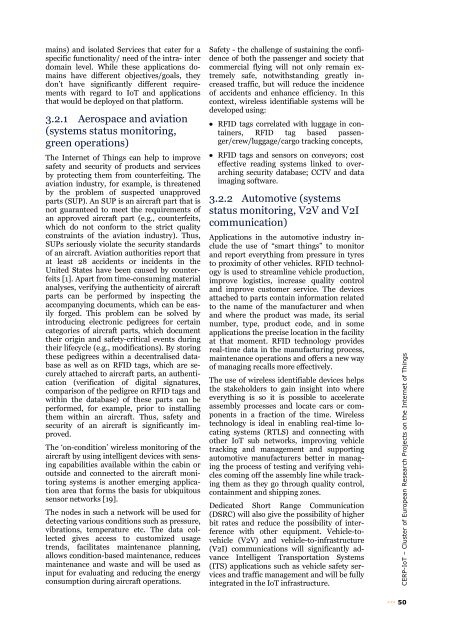Vision and Challenges for Realising the Internet of Things
Vision and Challenges for Realising the Internet of Things
Vision and Challenges for Realising the Internet of Things
You also want an ePaper? Increase the reach of your titles
YUMPU automatically turns print PDFs into web optimized ePapers that Google loves.
mains) <strong>and</strong> isolated Services that cater <strong>for</strong> a<br />
specific functionality/ need <strong>of</strong> <strong>the</strong> intra- inter<br />
domain level. While <strong>the</strong>se applications domains<br />
have different objectives/goals, <strong>the</strong>y<br />
don’t have significantly different requirements<br />
with regard to IoT <strong>and</strong> applications<br />
that would be deployed on that plat<strong>for</strong>m.<br />
3.2.1 Aerospace <strong>and</strong> aviation<br />
(systems status monitoring,<br />
green operations)<br />
The <strong>Internet</strong> <strong>of</strong> <strong>Things</strong> can help to improve<br />
safety <strong>and</strong> security <strong>of</strong> products <strong>and</strong> services<br />
by protecting <strong>the</strong>m from counterfeiting. The<br />
aviation industry, <strong>for</strong> example, is threatened<br />
by <strong>the</strong> problem <strong>of</strong> suspected unapproved<br />
parts (SUP). An SUP is an aircraft part that is<br />
not guaranteed to meet <strong>the</strong> requirements <strong>of</strong><br />
an approved aircraft part (e.g., counterfeits,<br />
which do not con<strong>for</strong>m to <strong>the</strong> strict quality<br />
constraints <strong>of</strong> <strong>the</strong> aviation industry). Thus,<br />
SUPs seriously violate <strong>the</strong> security st<strong>and</strong>ards<br />
<strong>of</strong> an aircraft. Aviation authorities report that<br />
at least 28 accidents or incidents in <strong>the</strong><br />
United States have been caused by counterfeits<br />
[1]. Apart from time-consuming material<br />
analyses, verifying <strong>the</strong> au<strong>the</strong>nticity <strong>of</strong> aircraft<br />
parts can be per<strong>for</strong>med by inspecting <strong>the</strong><br />
accompanying documents, which can be easily<br />
<strong>for</strong>ged. This problem can be solved by<br />
introducing electronic pedigrees <strong>for</strong> certain<br />
categories <strong>of</strong> aircraft parts, which document<br />
<strong>the</strong>ir origin <strong>and</strong> safety-critical events during<br />
<strong>the</strong>ir lifecycle (e.g., modifications). By storing<br />
<strong>the</strong>se pedigrees within a decentralised database<br />
as well as on RFID tags, which are securely<br />
attached to aircraft parts, an au<strong>the</strong>ntication<br />
(verification <strong>of</strong> digital signatures,<br />
comparison <strong>of</strong> <strong>the</strong> pedigree on RFID tags <strong>and</strong><br />
within <strong>the</strong> database) <strong>of</strong> <strong>the</strong>se parts can be<br />
per<strong>for</strong>med, <strong>for</strong> example, prior to installing<br />
<strong>the</strong>m within an aircraft. Thus, safety <strong>and</strong><br />
security <strong>of</strong> an aircraft is significantly improved.<br />
The ‘on-condition’ wireless monitoring <strong>of</strong> <strong>the</strong><br />
aircraft by using intelligent devices with sensing<br />
capabilities available within <strong>the</strong> cabin or<br />
outside <strong>and</strong> connected to <strong>the</strong> aircraft monitoring<br />
systems is ano<strong>the</strong>r emerging application<br />
area that <strong>for</strong>ms <strong>the</strong> basis <strong>for</strong> ubiquitous<br />
sensor networks [19].<br />
The nodes in such a network will be used <strong>for</strong><br />
detecting various conditions such as pressure,<br />
vibrations, temperature etc. The data collected<br />
gives access to customized usage<br />
trends, facilitates maintenance planning,<br />
allows condition-based maintenance, reduces<br />
maintenance <strong>and</strong> waste <strong>and</strong> will be used as<br />
input <strong>for</strong> evaluating <strong>and</strong> reducing <strong>the</strong> energy<br />
consumption during aircraft operations.<br />
Safety - <strong>the</strong> challenge <strong>of</strong> sustaining <strong>the</strong> confidence<br />
<strong>of</strong> both <strong>the</strong> passenger <strong>and</strong> society that<br />
commercial flying will not only remain extremely<br />
safe, notwithst<strong>and</strong>ing greatly increased<br />
traffic, but will reduce <strong>the</strong> incidence<br />
<strong>of</strong> accidents <strong>and</strong> enhance efficiency. In this<br />
context, wireless identifiable systems will be<br />
developed using:<br />
RFID tags correlated with luggage in containers,<br />
RFID tag based passenger/crew/luggage/cargo<br />
tracking concepts,<br />
RFID tags <strong>and</strong> sensors on conveyors; cost<br />
effective reading systems linked to overarching<br />
security database; CCTV <strong>and</strong> data<br />
imaging s<strong>of</strong>tware.<br />
3.2.2 Automotive (systems<br />
status monitoring, V2V <strong>and</strong> V2I<br />
communication)<br />
Applications in <strong>the</strong> automotive industry include<br />
<strong>the</strong> use <strong>of</strong> “smart things” to monitor<br />
<strong>and</strong> report everything from pressure in tyres<br />
to proximity <strong>of</strong> o<strong>the</strong>r vehicles. RFID technology<br />
is used to streamline vehicle production,<br />
improve logistics, increase quality control<br />
<strong>and</strong> improve customer service. The devices<br />
attached to parts contain in<strong>for</strong>mation related<br />
to <strong>the</strong> name <strong>of</strong> <strong>the</strong> manufacturer <strong>and</strong> when<br />
<strong>and</strong> where <strong>the</strong> product was made, its serial<br />
number, type, product code, <strong>and</strong> in some<br />
applications <strong>the</strong> precise location in <strong>the</strong> facility<br />
at that moment. RFID technology provides<br />
real-time data in <strong>the</strong> manufacturing process,<br />
maintenance operations <strong>and</strong> <strong>of</strong>fers a new way<br />
<strong>of</strong> managing recalls more effectively.<br />
The use <strong>of</strong> wireless identifiable devices helps<br />
<strong>the</strong> stakeholders to gain insight into where<br />
everything is so it is possible to accelerate<br />
assembly processes <strong>and</strong> locate cars or components<br />
in a fraction <strong>of</strong> <strong>the</strong> time. Wireless<br />
technology is ideal in enabling real-time locating<br />
systems (RTLS) <strong>and</strong> connecting with<br />
o<strong>the</strong>r IoT sub networks, improving vehicle<br />
tracking <strong>and</strong> management <strong>and</strong> supporting<br />
automotive manufacturers better in managing<br />
<strong>the</strong> process <strong>of</strong> testing <strong>and</strong> verifying vehicles<br />
coming <strong>of</strong>f <strong>the</strong> assembly line while tracking<br />
<strong>the</strong>m as <strong>the</strong>y go through quality control,<br />
containment <strong>and</strong> shipping zones.<br />
Dedicated Short Range Communication<br />
(DSRC) will also give <strong>the</strong> possibility <strong>of</strong> higher<br />
bit rates <strong>and</strong> reduce <strong>the</strong> possibility <strong>of</strong> interference<br />
with o<strong>the</strong>r equipment. Vehicle-tovehicle<br />
(V2V) <strong>and</strong> vehicle-to-infrastructure<br />
(V2I) communications will significantly advance<br />
Intelligent Transportation Systems<br />
(ITS) applications such as vehicle safety services<br />
<strong>and</strong> traffic management <strong>and</strong> will be fully<br />
integrated in <strong>the</strong> IoT infrastructure.<br />
CERP-IoT – Cluster <strong>of</strong> European Research Projects on <strong>the</strong> <strong>Internet</strong> <strong>of</strong> <strong>Things</strong><br />
50
















